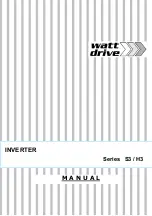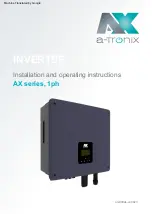
User Manual
For running the inverter on a DC power supply, it is important the check the current from power source is
sufficient to run the inverter at full load. The required current to allow the inverter to operate at full load
can be estimated from the continuous output power of the inverter and input power voltage. For example
a 1500W 12V input inverter at maximum load will require input current of:
1500 / 12 = 125 Amp
In reality the current requirement will be higher to compensate the power lost during the DC – AC
conversion and the power lost from the cable.
From the above calculation please choose your power source set up for the inverter carefully to suit the
purpose of use in terms of both duration and load.
The start-up load is also a major factor of whether the inverter is capable to power up the appliance.
Although the start-up load peaks for a fraction of a second, the start-up load is normally twice as much as
the rated continuous power of the appliance. In some equipment the start-up load can be as high as 8
times of its continuous power, especially on inductive loads that include an electric motor.
This inverter can withstand the momentary start-up load for up to 2 times of its rated continuous output
power for up to 2 seconds. To determine if the inverter is capable to start up an appliance, simply test it
by plugging it in and running it. If the start-up current peaks higher than the highest power inverter can
supply, it will trigger the over load protection, which creates a buzz and the fault LED indicator will light to
indicate there is a fault.
BATTERY ARRAY CONNECTION:
To increase the duration of inverter operation while running on battery, multiple batteries can be linked
together to increase the total capacity and duration. The below diagram shows the common ways to wire
typical 12V 75Ah batteries together to increase the capacity for both 12V and 24V output:
12V OUTPUT – PARALLEL CONNECTION (voltage remains current increase)





























